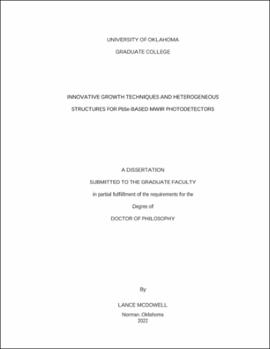| dc.description.abstract | Lead-chalcogenide semiconductor materials such as PbSe are an attractive class of narrow band-gap semiconductors due to their unique optical and electrical properties, finding their way into numerous mid-wave infrared (MWIR) optoelectronic and topological device applications. While PbSe is a mature material system with research efforts dating back almost a century, the full potential of its physical properties has yet to be realized in fabricated devices. Much of the difficulty lies in the unique bonding nature and crystal structure of PbSe films, which gives both advantageous MWIR optoelectrical properties along with a limited selection of suitable substrates for high-quality growth. Further, PbSe homojunction devices on dissimilar substrates face issues with doping, where diffusion of PbSe dopants through defect channels inhibit the formation of an abrupt junction resulting in degraded device performance. Further, p-n heterojunction formation with PbSe is difficult due to the small bandgap of PbSe, resulting in a shortlist of suitable materials with the corresponding band alignment to form a type-II heterojunction. Even for material systems that share a suitable band alignment, issues often arise with dissimilar crystallinity, lattice constant, and thermal expansion coefficient. The dissimilarity between these films introduces large stress/ strain relations at the interface, resulting in the formation of cracks or dislocations which ruin the interface and bulk electrical properties. For these reasons, PbSe-based MWIR devices have been surpassed by more competitive material systems such as II-VI HgCdTe, and Sb-based type-II superlattices.
In this work, new methods for improving PbSe film quality are explored, along with the growth and design of new heterogeneous structures and MWIR photodetectors which may improve the PbSe-based MWIR sensing platform. Presented here will be a new approach for creating heterogeneous material structures with PbSe by molecular beam epitaxy (MBE). Demonstration of a new heterogenous p-n junction structure between mismatched germanium substrates and epitaxial lead selenide thin-films will be introduced utilizing a vicinal growth surface. Extending from this, epitaxial PbSe films with enhanced surface morphology will also be demonstrated on vicinal silicon substrates, showcasing record low surface defect densities compared to traditional growth on nominal silicon. Regarding the former, germanium will also serve as an active layer in the formation of a p-n heterojunction structure due to its suitable type-II band alignment with PbSe. However, large differences in lattice constant and thermal expansion coefficient will need to be addressed to form such a structure. These challenges are tackled by optimizing the surface kinetics of PbSe adatoms through high-temperature surface treatment, along with utilizing misfit accommodation steps induced by the periodic atomic step edges from the high degree of vicinal miscut of the germanium growth surface. Further, different structures and device applications of PbSe-based material systems will be explored, including the growth of a new PbOSe complex oxide thin-film via oxygen-plasma assisted MBE deposition. Fabrication of a single phase (cubic) all-epitaxial n-CdSe/p-PbSe heterojunction structure with room temperature MWIR detection capabilities will also be presented, along with the fabrication of MWIR transparent contacts using cadmium oxide thin-films for enhanced photodetector device design. The combined results of these efforts provide multiple avenues for the development of state-of-the-art MWIR PbSe-based photodetectors, enabling future commercial MWIR sensing capabilities with reduced size, weight, power consumption, and cost. | en_US |

